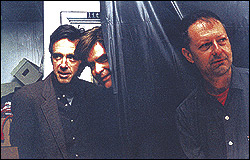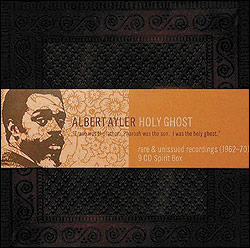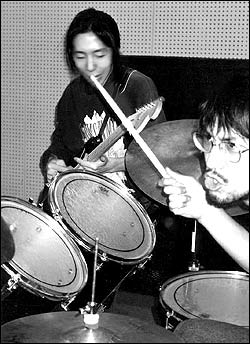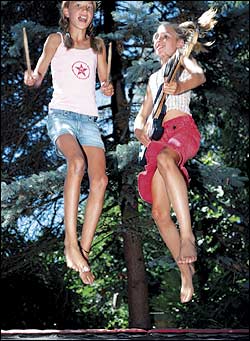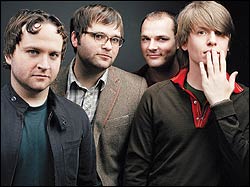The sign of “live”-ness in a live recording doesn’t come from the performers but from the audience—the sound of their applause. Mission of Burma’s 1985 live album, The Horrible Truth About Burma, in its original configuration, ends with an apocalyptic cover of Pere Ubu’s “Heart of Darkness,” followed by the sound of an enthusiastic but tiny crowd cheering and clapping into a silence that’s much bigger than they are; they’re cheering Burma on, encouraging them, almost apologizing for the rest of the world that’s not there to clap.
The reunited Burma have just released Snapshot (available only as an iTunes download), a roaring eight-song live EP recorded in front of what sounds like an even smaller invited audience. It’s almost all old Burma standards, except for drummer Peter Prescott’s halfway-to-free-form outburst “Absent Mind” and a barn-burning cover of “Youth of America,” by pioneering Portland punks the Wipers. The applause and cheers are just as vigorous this time as they were on Horrible Truth but somehow less desperate and more grateful. Burma took a couple of decades off, and weirdly enough improved while they were away—they’re playing better, individually and collectively. The instrumental “Tremelo” opens both live albums: On Horrible Truth, it’s a sharp little idea, a simple riff built around a trick from a guitar pedal; and on Snapshot, it’s eight minutes of the sky being torn open. Bassist Clint Conley lets a little laugh escape as the applause starts—the band’s been spotted making that amazing noise.
Burma are justly proud of their live power and chemistry—they claim they’ve never used the same set list twice—so it’s notable that tape loops are a huge part of their sound. But they don’t quite know what the loops are going to be: Sound engineer Bob Weston records elements of each performance on analog tape, mutates them, and feeds them back into the mix. A minute into the Snapshot version of “Mica,” for instance, Conley’s voice seems to be going haywire. He’ll finish a word, then seem to call it back from the air and suck it into his throat again. It’s actually Weston flipping Conley’s singing backward and batting it back to him. At a show in Philadelphia early this year, Weston looped a few seconds of guitarist Roger Miller’s voice from “Max Ernst” and kept it feeding through the speakers for minutes, as the band finished the song, thanked the audience, walked offstage, and finally came back: “dada, dada, dada,” over and over, as we clapped and clapped.
Why applaud? To make a noise, to show approval, because it’s part of the social contract of seeing a performance. (The Magnetic Fields’ Stephin Merritt, who has hearing problems, reportedly requests that his audience shows its appreciation by snapping fingers instead of clapping.) Applause is an artless noise; it reinforces the power relationship between the receptive mass slapping its palms together and the (relatively) focused expertise on the stage. It also can be a demand for a present everyone knows will be awarded, a way to call back a performer for the inevitable encore, the lagniappe without which we consider our experience incomplete.
If you want to hear applause for its own sake, there’s Autodigest’s A Compressed History of Everything Ever Recorded, Vol. 2: Ubiquitous Eternal Live (Ash International/Crónica). The back cover describes it as a “spontaneous, improvised, slow crescendo by every audience ever.” It is exactly an hour of applause, bookended by a commanding voice twice announcing, “Thank you! Good night!” It’s not just the kind of ooh-that’s-good applause heard on Burma’s live albums; it’s riotous, maniacal, progressively louder and more rapturous clapping and cheering from an audience that demands more. Shrieks leap out of it like dolphins. As the shouting and clapping redoubles and layers over itself, faint patterns emerge. They become overtones, notes, even faint tunelets. The applause can become the featured attraction, and does to anyone who buys or hears the album. It can go on forever. “Best played in ‘Repeat’ mode,” a note says.
There’s one other brilliant joke on Ubiquitous Eternal Live: When you put the CD in a computer, it identifies itself as “I am sitting in a room.” That’s the title of a 1966 piece by composer Alvin Lucier, in which he recorded himself reading a short text about what he was doing (and stuttering a bit), then played it back in the room where he’d recorded it and recorded that, and repeated the process until the decay of the source material and the room’s resonant frequencies had together evolved into a single faintly fluctuating tone that sounds like the overtones of the applause. (Mission of Burma’s Miller actually did something conceptually similar on his 1990 album Oh (guitars, etc . . . ): “F.W.R.,” short for “The Fun World Reductions,” is a series of playbacks of Burma’s recording “Fun World,” doubling the speed each time, until it’s no more than a quarter-second burst of trebly static.)
On the front cover of Ubiquitous Eternal Live, there’s a picture of an empty bed being hit by morning sunlight; the audience is still out clapping, or maybe we’re the audience. Behind the disc itself, there are two X-rays of hands. An audience’s unsated desire for more can make them slam together hard, hundreds of times. What will it do to those bones?
